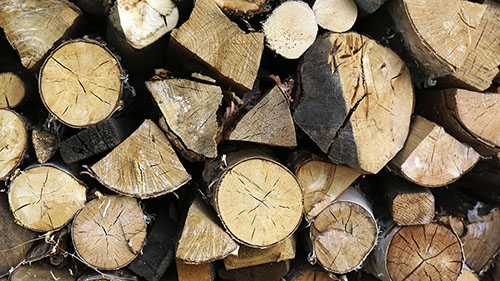Stack It, Store It, Use It
Dec 06, 2021

On cold nights, nothing feels better than curling up next to a toasty fire with a good book and hot chocolate in hand. However, what if you go out to your woodpile only to find that it is soaking wet, or that your dry-looking log is just damp enough on the inside to prevent it from burning? Most likely you will not want to get out in the freezing temperatures and drive all the way to the store for firewood.
Don’t let bad stacking practices interrupt your plans. Learn how to store your firewood for seasoning so that you are prepared for the months ahead!
Understand the importance of seasoning
“Seasoning” simply means reducing the moisture content of your wood from 50% to between 15% and 20%. Well-seasoned logs are easier to burn, longer-lasting, and produce less emissions. If your firewood is not well-seasoned, it will be hard to light and will likely not stay lit for long.
Cut the wood to size
Before you stack your wood, cut each piece to the correct length and width of your fireplace or wood stove. A common log size is about 16 inches long and 6 inches thick, but the smaller the piece, the quicker the drying time.
Allow to dry
In order for the wood to season, it must be allowed to dry in the sun and wind. Stack the logs in single rows to maximize airflow with the long dimension of your pile facing the prevailing wind. Also, keep your split logs’ cut-end facing towards the wind for even faster drying times. As the sun evaporates the moisture from the wood, the wind will whisk it away.
Protect from moisture
Protect your woodpile from rain and snow by storing it under an open-sided shed or by covering it with a tarp. If you must use a tarp, don’t stake it tight to the ground; let it loosely cover the top so that the outdoor air is allowed to reach the sides of the stack to help the wood dry. Once your wood is completely dry, you can cover it completely. Because moisture can seep into your wood from the ground as well, keep your pile elevated by stacking it on a pallet or rack.
Let the wood season
The time it takes to season wood is quite variable depending on factors such as weather and storage. On average, it takes six months for wood to cure, but sometimes it can take as little as three months or as long as a year.
Visit your local Co-op for tools such as axes and tarps, as well as for more tips on preparing for the winter season. For more content like this, check out the latest issue of the Cooperator.
Don’t let bad stacking practices interrupt your plans. Learn how to store your firewood for seasoning so that you are prepared for the months ahead!
Understand the importance of seasoning
“Seasoning” simply means reducing the moisture content of your wood from 50% to between 15% and 20%. Well-seasoned logs are easier to burn, longer-lasting, and produce less emissions. If your firewood is not well-seasoned, it will be hard to light and will likely not stay lit for long.
Cut the wood to size
Before you stack your wood, cut each piece to the correct length and width of your fireplace or wood stove. A common log size is about 16 inches long and 6 inches thick, but the smaller the piece, the quicker the drying time.
Allow to dry
In order for the wood to season, it must be allowed to dry in the sun and wind. Stack the logs in single rows to maximize airflow with the long dimension of your pile facing the prevailing wind. Also, keep your split logs’ cut-end facing towards the wind for even faster drying times. As the sun evaporates the moisture from the wood, the wind will whisk it away.
Protect from moisture
Protect your woodpile from rain and snow by storing it under an open-sided shed or by covering it with a tarp. If you must use a tarp, don’t stake it tight to the ground; let it loosely cover the top so that the outdoor air is allowed to reach the sides of the stack to help the wood dry. Once your wood is completely dry, you can cover it completely. Because moisture can seep into your wood from the ground as well, keep your pile elevated by stacking it on a pallet or rack.
Let the wood season
The time it takes to season wood is quite variable depending on factors such as weather and storage. On average, it takes six months for wood to cure, but sometimes it can take as little as three months or as long as a year.
Visit your local Co-op for tools such as axes and tarps, as well as for more tips on preparing for the winter season. For more content like this, check out the latest issue of the Cooperator.